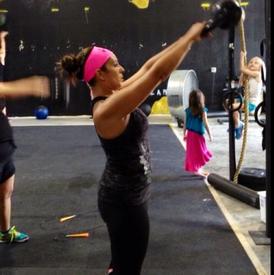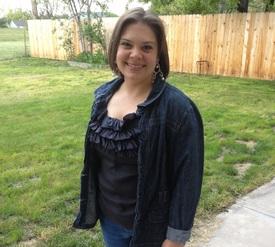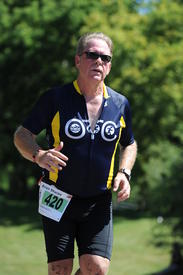Running on Pavement question

BAMFMeredith
Posts: 2,810 Member
I run 3x a week, usually 2 days on the treadmill doing HIIT and one day on an outdoor running trail doing a long distance run (usually 8-10 miles). I rarely run on sidewalk/asphalt, but when I do I am in PAIN. It was a beautiful day yesterday so I decided to get a little run in after work just around my neighborhood, but 2 miles in I had to stop because my shins and knees hurt so bad. It's so weird, I can run forever on the trail but on the pavement it's like torture.
And even stranger, I ran a half marathon last month that was all on pavement and I was fine, I didn't have any of the pain, but I'm guessing that was due to the adrenaline. What gives? Should I just continue to run on the treadmill/trails and avoid pavement, or should I suffer through it to get my body used to running on the asphalt?
And even stranger, I ran a half marathon last month that was all on pavement and I was fine, I didn't have any of the pain, but I'm guessing that was due to the adrenaline. What gives? Should I just continue to run on the treadmill/trails and avoid pavement, or should I suffer through it to get my body used to running on the asphalt?
0
Replies
-
-
IME, trail running is totally different than road running. Obviously the dirt is more forgiving than the pavement, but my stride is totally different. Road running I get into a grove and just go... stride is basically the same start to finish. Trail running has a different stride every step because I'm constantly adjusting my stride/step for rocks/roots, off-camber spots, etc. I'm MUCH more forward, much more on the balls of my feet when trail running than when road running.
Also, because the dirt (and treadmill for that matter) are so forgiving, shoe fit/support is somewhat less important from a pain/comfort perspective.0 -
If you have trouble on the pavement, I'd avoid it. It's probably the worst form of running a person can do. They recommend asphalt over pavement because they say the asphalt gives a tad.0
-
I'm just a bit worried about doing more damage than good in the beginning...perhaps I need shoes with some more cushion for pavement running as opposed to treadmill/trail running?0
-
If you have trouble on the pavement, I'd avoid it. It's probably the worst form of running a person can do. They recommend asphalt over pavement because they say the asphalt gives a tad.
This isn't true at all. You don't need to avoid it. You just need better shoes. Go to a running store, and get fitted.
Whoever above said that you need to train on pavement/asphalt is correct. Dirt and treadmills have MUCH more give.0 -
If you have trouble on the pavement, I'd avoid it. It's probably the worst form of running a person can do. They recommend asphalt over pavement because they say the asphalt gives a tad.
This isn't true at all. You don't need to avoid it. You just need better shoes. Go to a running store, and get fitted.
Whoever above said that you need to train on pavement/asphalt is correct. Dirt and treadmills have MUCH more give.
The shoes I'm running in now I got fitted for, but maybe I need to explain my problem to the guy at the running store, might be able to point me in the direction of a better pavement/asphalt shoe.0 -
If you have trouble on the pavement, I'd avoid it. It's probably the worst form of running a person can do. They recommend asphalt over pavement because they say the asphalt gives a tad.
This isn't true at all. You don't need to avoid it. You just need better shoes. Go to a running store, and get fitted.
Whoever above said that you need to train on pavement/asphalt is correct. Dirt and treadmills have MUCH more give.
Yeah, you could try new shoes. But, that wouldn't be my answer to the problem. If it hurts, don't do it. Unless you like pain. I'm assuming it's not the good pain, you are talking about, but more like a bad pain.0 -
A lot of people are saying to avoid it...however, if you plan to do any races that are not trail races, then I would just work on acclimating yourself to it. No sense doing all of your training on trails and treadmills and then doing a race on pavement, right?0
-
A lot of people are saying to avoid it...however, if you plan to do any races that are not trail races, then I would just work on acclimating yourself to it. No sense doing all of your training on trails and treadmills and then doing a race on pavement, right?
Yeah, I mean if I didn't do races, I wouldn't worry about it, but like 95% of the races I do are on pavement/asphalt. I don't ever experience pain during the races, although after, I'm usually in a WORLD of joint pain. Think I'll look into some new shoes and just incorporate the pavement running into my routine and get through the pain.0 -
Assuming it's just an adjustment period from not spending much time on pavement, there is some truth in the suck it up and push through it approach.0
-
shin splints occur when you change running surfaces-its normal
happens to me every year when I switch from running on my treadmill in the winter to running outside in the summer-nothing you can really do.
but if joint pain is an issue-are you taking some kind of joint support-very beneficial for runners0 -
Sometimes, if you have bad running form, it can lead to pain. My husband is bow legged. His form is horrible to when he runs (makes clomping noises). I think it contributes to his knees hurting. So I would ask someone to see you run. You should barely hear yourself when you run, both treadmill and pavement.0
-
If you have trouble on the pavement, I'd avoid it. It's probably the worst form of running a person can do. They recommend asphalt over pavement because they say the asphalt gives a tad.
This isn't true at all. You don't need to avoid it. You just need better shoes. Go to a running store, and get fitted.
Whoever above said that you need to train on pavement/asphalt is correct. Dirt and treadmills have MUCH more give.
The shoes I'm running in now I got fitted for, but maybe I need to explain my problem to the guy at the running store, might be able to point me in the direction of a better pavement/asphalt shoe.
How old are your shoes? They aren't built to last forever... I think (and could be wrong) that you should get new shoes ever 500-700 miles you run in them. So if you are using your shoes for everyday walking that will wear them out even faster. I normally get new shoes every 6 to 8 months depending on how much I run 0
0 -
Check your shoes....if you just ran a Half you shouldn't have that much pain after 2 miles....good shoes (fitted by a running store) have cured a lot of my pains/ills.0
-
If you have trouble on the pavement, I'd avoid it. It's probably the worst form of running a person can do. They recommend asphalt over pavement because they say the asphalt gives a tad.
This isn't true at all. You don't need to avoid it. You just need better shoes. Go to a running store, and get fitted.
Whoever above said that you need to train on pavement/asphalt is correct. Dirt and treadmills have MUCH more give.
The shoes I'm running in now I got fitted for, but maybe I need to explain my problem to the guy at the running store, might be able to point me in the direction of a better pavement/asphalt shoe.
How old are your shoes? They aren't built to last forever... I think (and could be wrong) that you should get new shoes ever 500-700 miles you run in them. So if you are using your shoes for everyday walking that will wear them out even faster. I normally get new shoes every 6 to 8 months depending on how much I run
Mine are pretty new, I replace them every 400 miles or so. I have a separate pair for non running days and I wear an old pair if I'm running errands or doing something non-athletic. I'm a little anal when it comes to the shoes haha
But I'll hit up my running store in the next week or so and get fitted again, just to see if maybe there is a better pair for my pavement running.0 -
I just started running on the roads, and have begun to adopt some of the techniques used in "natural running". This has made me shorten my strides, and land more on the balls of my feet which seems to help a lot with reducing the impact on my knees and ankles. After a couple of runs I have no pain (other than screaming leg muscles the next morning).0
-
I just started running on the roads, and have begun to adopt some of the techniques used in "natural running". This has made me shorten my strides, and land more on the balls of my feet which seems to help a lot with reducing the impact on my knees and ankles. After a couple of runs I have no pain (other than screaming leg muscles the next morning).
Changing the way I ran helped reduce a lot of the knee pains/shin splints that have always plagued me in the past. I would recommend running barefoot (indoors or on grass, somewhere that won't hurt) and seeing how you strike the ground naturally. If the way you are running when wearing your shoes differs quite a bit I would work on trying to change how you run to mimic how you ran barefoot.0 -
i would switch one of your shorter treadmill runs to an outdoor run until pavement running becomes more comfortable. keep the longer one on the treadmill and slowly work your way to more pavement running. maybe using jeff galloway's method of run/walk when you are outside will help.0
-
I just started running on the roads, and have begun to adopt some of the techniques used in "natural running". This has made me shorten my strides, and land more on the balls of my feet which seems to help a lot with reducing the impact on my knees and ankles. After a couple of runs I have no pain (other than screaming leg muscles the next morning).
Changing the way I ran helped reduce a lot of the knee pains/shin splints that have always plagued me in the past. I would recommend running barefoot (indoors or on grass, somewhere that won't hurt) and seeing how you strike the ground naturally. If the way you are running when wearing your shoes differs quite a bit I would work on trying to change how you run to mimic how you ran barefoot.
I'm actually REALLY interested in the barefoot (or barefoot style) running. I have a couple more races I'm training for in the next month or so, so I don't wanna just straight up switch styles right before a race, but once those are done I may try the minimalist approach. I'm currently a mid-foot striker, and I've been interested in switching to a more lightweight minimal style shoe (I can't deal with the toes in the Vibrams). Might help a lot. Thanks! Oh and to answer somebody else's question about supplements I do take an multi-vitamin (Emerald Labs vegan food rich multi in capsules) and an omega-3 fish oil supplement 3 times a day and I have prescription anti-inflammatories for some long time tendonitis that flares up every now and then (I've had this for at least 10 years, I used to be a dancer).0 -
I think the advice regarding stride has some real merit.
Typically you'll lengthen your stride on a treadmill to accommodate the fact that the belt is providing a certain amount of propulsion, when running outdoors you want to shorten your stride for a midfoot strike. For me one of the best decisions I made was to run outdoors all year 'round - in slippery winter conditions you have to shorten your stride unless you plan on falling flat on your butt.0 -
I just started running on the roads, and have begun to adopt some of the techniques used in "natural running". This has made me shorten my strides, and land more on the balls of my feet which seems to help a lot with reducing the impact on my knees and ankles. After a couple of runs I have no pain (other than screaming leg muscles the next morning).
Changing the way I ran helped reduce a lot of the knee pains/shin splints that have always plagued me in the past. I would recommend running barefoot (indoors or on grass, somewhere that won't hurt) and seeing how you strike the ground naturally. If the way you are running when wearing your shoes differs quite a bit I would work on trying to change how you run to mimic how you ran barefoot.
I'm actually REALLY interested in the barefoot (or barefoot style) running. I have a couple more races I'm training for in the next month or so, so I don't wanna just straight up switch styles right before a race, but once those are done I may try the minimalist approach. I'm currently a mid-foot striker, and I've been interested in switching to a more lightweight minimal style shoe (I can't deal with the toes in the Vibrams). Might help a lot. Thanks! Oh and to answer somebody else's question about supplements I do take an multi-vitamin (Emerald Labs vegan food rich multi in capsules) and an omega-3 fish oil supplement 3 times a day and I have prescription anti-inflammatories for some long time tendonitis that flares up every now and then (I've had this for at least 10 years, I used to be a dancer).
Everything said here is perfection! I get shin splints too most days I run but, I believe that some people can push through the pain better then others. I think if you try to scale back a little and build up your tolerance for hard surfaces, you will be greatly rewarded.
Most people have trouble switching between the hard and the soft surfaces just like we may have a hard time switching from firm to plush beds. Your body gets use to one thing and has a hard time adjusting to something new.
I love the idea of minimalist running. I think it strengthens our legs and feet that have been made lazy by "Over supportive, cushioned,expensive, fancy" running shoes. Truth be told, I think that well broken in running shoes are better for us then the newest pair of XXXX brand, gel,foam,air, spring supportive shoes.
I agree with you that I wouldn't work with minimalist footwear untill your done with your race. You have to take alot of time to get acclimated to running with less support and you wouldn't wanna injure yourself befor your race. I have read alot on the idea and I can't wait to get my first pair of "Less is more" shoes! I have run completely barefoot a few times now for .5 to 1.5 miles. Just that little taste is enough to make me want more :-)
Best of luck on you splints. I have heard that reverse calf raises help but I have never tried them.
0 -
I have the same problem UNTIL I bought compression sleeves from a Run Shop nearby. They were $40 and worth every penny (cheaper on Ebay) GET THEM!! They are like miracle workers. They hold your muscles to you shin and I have not had shin soreness since I've been wearing them. I also take glucosamine/chondoitin supplements daily and no longer have any knee pain! Good Luck!
 0
0 -
I just started running on the roads, and have begun to adopt some of the techniques used in "natural running". This has made me shorten my strides, and land more on the balls of my feet which seems to help a lot with reducing the impact on my knees and ankles. After a couple of runs I have no pain (other than screaming leg muscles the next morning).
Changing the way I ran helped reduce a lot of the knee pains/shin splints that have always plagued me in the past. I would recommend running barefoot (indoors or on grass, somewhere that won't hurt) and seeing how you strike the ground naturally. If the way you are running when wearing your shoes differs quite a bit I would work on trying to change how you run to mimic how you ran barefoot.
I'm actually REALLY interested in the barefoot (or barefoot style) running. I have a couple more races I'm training for in the next month or so, so I don't wanna just straight up switch styles right before a race, but once those are done I may try the minimalist approach. I'm currently a mid-foot striker, and I've been interested in switching to a more lightweight minimal style shoe (I can't deal with the toes in the Vibrams). Might help a lot. Thanks! Oh and to answer somebody else's question about supplements I do take an multi-vitamin (Emerald Labs vegan food rich multi in capsules) and an omega-3 fish oil supplement 3 times a day and I have prescription anti-inflammatories for some long time tendonitis that flares up every now and then (I've had this for at least 10 years, I used to be a dancer).
Changing to minimalist shoes has been really good for my running. If you don't like Vibrams I recommend Merrell's. They are very similar but without the seperated toes. A lot of people are wearing the NB minimus now as well. I liked the Merrell's better because of the fit (roomier toebox) but to each his/her own. I would definitely wait until after any upcoming races to change shoes though. Minimalist shoes can take a lot of transition time depending on the person because they work different muscles. I still deal with sore calf muscles after a hard run or really long run but it is not nearly as bad as when I first switched shoes. Ouch!0
This discussion has been closed.
Categories
- All Categories
- 1.4M Health, Wellness and Goals
- 398.3K Introduce Yourself
- 44.7K Getting Started
- 261K Health and Weight Loss
- 176.4K Food and Nutrition
- 47.7K Recipes
- 233K Fitness and Exercise
- 462 Sleep, Mindfulness and Overall Wellness
- 6.5K Goal: Maintaining Weight
- 8.7K Goal: Gaining Weight and Body Building
- 153.5K Motivation and Support
- 8.4K Challenges
- 1.4K Debate Club
- 96.5K Chit-Chat
- 2.6K Fun and Games
- 4.7K MyFitnessPal Information
- 17 News and Announcements
- 21 MyFitnessPal Academy
- 1.5K Feature Suggestions and Ideas
- 3.2K MyFitnessPal Tech Support Questions












